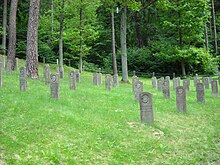
| 90–100% | |
| 70–90% | |
| 50–70% | Bosnia and Herzegovina |
| 30–40% | North Macedonia |
| 10–20% | |
| 5–10% | |
| 4–5% | |
| 2–4% | |
| 1–2% | |
| < 1% |
| Islam by country |
|---|
 |
|
|


| Islam by country |
|---|
 |
|
|
Islam in Lithuania, unlike many other northern and western European countries, has a long history starting from the 14th century.[2] The medieval Grand Duchy of Lithuania of the Polish–Lithuanian Commonwealth, stretching from the Baltic to Black seas, included several Muslim lands in the south inhabited by Crimean Tatars.[3] A few Muslims migrated to ethnically Lithuanian lands, now the current Republic of Lithuania, mainly during the rule of Grand Duke Vytautas (early 15th century). The Tatars, now referred to as Lithuanian Tatars, lost their language over time and now speak Lithuanian; however, they maintained Islam as their religion. Due to the long isolation from the greater Islamic world, the practices of the Lithuanian Tatars differ somewhat from the rest of Sunni Muslims; they are not considered a separate sect, however, although some of the Lithuanian Tatars practice what could be called Folk Islam. One anonymous Lithuanian Tatar who made Hajj to Mecca acknowledged in his work the risale that the Lithuanian Tatars had unorthodox customs and rituals so that they could possibly be viewed as infidel (kafir) from the perspective of orthodox Muslims.[4]
In Lithuania, unlike many other European societies at the time, there was religious freedom. Lithuanian Tatars settled in certain places, such as around Raižiai (in Alytus district municipality).
Much of the Lithuanian Tatar culture, mosques, graveyards and such were destroyed by the Soviet Union after it annexed Lithuania. After restoration of Lithuanian independence however the government supported the promotion of Lithuanian Tatar culture among those Lithuanian Tatars who lost it. Three original wooden mosques remain now (in villages of Nemėžis, Keturiasdešimt Totorių (both in Vilnius district municipality) and Raižiai (Alytus district municipality), typically having relatively large Muslim populations), as well as a new brick mosque built in Kaunas during the period of interwar independence of Lithuania (in the 1930s) to commemorate the anniversary of Vytautas, the duke who brought Tatars and Islam to Lithuania. That mosque is called Vytautas Didysis Mosque after the Grand Duke Vytautas. In the capital of Lithuania, Vilnius, however, no mosque remains, as Russians destroyed the Lukiškės Mosque which was there. The Lithuanian Tatar community is trying to rebuild the mosque, but faces various problems, including lack of funds as well as certain actions by the government of Vilnius city municipality.
Currently, only several thousand Lithuanian Tatars remain, making up an estimated 0.1% of the country's population;[5] however, with the restoration of Lithuanian independence, they are experiencing a kind of national revival with evidence to suggest there are several hundred non-Tartar converts to Islam.[6]
During the time of the Soviet Union, some people from other Muslim nationalities were moved in, however many of them were atheists; as well other Muslims came as immigrants after restoration of independence, but as for now this number is very small compared to similar numbers in western Europe; therefore Lithuanian Tatars remain the core of Islam in Lithuania, supported by some Lithuanians who converted. Halal meat in the country remains difficult to obtain, with more observant Muslims slaughtering animals themselves.[7]
Gallery[edit]
-
One of the earliest Muslim mosques in Lithuania.
-
Lithuanian Tatars of Napoleonic army.
See also[edit]
References[edit]
- ^ "Religious Composition by Country, 2010-2050". Pew Research Center. 12 April 2015. Retrieved 22 October 2017.
- ^ Górak-Sosnowska, Katarzyna. (2011). Muslims in Poland and Eastern Europe : widening the European discourse on Islam. University of Warsaw. Faculty of Oriental Studies. pp. 207–208. ISBN 9788390322957. OCLC 804006764.
- ^ Akiner, Shirin (1983). Islamic Peoples of the Soviet Union. Kegan Paul International. p. 85. ISBN 978-0-7103-0025-6.
- ^ Shirin Akiner (2009). Religious Language of a Belarusian Tatar Kitab: A Cultural Monument of Islam in Europe : with a Latin-script Transliteration of the British Library Tatar Belarusian Kitab (OR 13020) on CD-ROM. Otto Harrassowitz Verlag. pp. 51–. ISBN 978-3-447-03027-4.
- ^ Račius, E. (2013). Lithuanian Muslims’ Attitudes Toward Participation in the Democratic Political Process. Muslim Political Participation in Europe. Edited by J. S. Nielsen. Edinburgh, Edinburgh University Press: 83-101., pg. 84
- ^ Račius, E. (2013). Lithuanian Muslims’ Attitudes Toward Participation in the Democratic Political Process. Muslim Political Participation in Europe. Edited by J. S. Nielsen. Edinburgh, Edinburgh University Press: 83-101., pg. 85
- ^ "Eastern Europe and migrants: The mosques of Lithuania". The Economist. 14 September 2015. Retrieved 20 September 2015.
External links[edit]
- Site of Lithuanian Islam community (in Lithuanian)
- Lithuanian mosques (in French)

